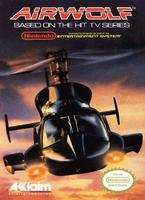Airwolf (video game)
| Airwolf | |
|---|---|
 NES box art | |
| Developer(s) | Kyugo (Arcade, Genesis) Beam Software (NES) |
| Publisher(s) | Kyugo (Arcade, Japan, Genesis, Japan/US) United Artists Theatre Amusements (Arcade, US) Acclaim (NES) |
| Platform(s) | Arcade, Amstrad CPC, Atari 8-bit, Commodore 64, Famicom, NES, Genesis, ZX Spectrum |
| Release | Arcade September 1987[1] Famicom NES Genesis |
| Genre(s) | Scrolling shooter |
| Mode(s) | Single-player |
| Arcade system | Kyugo |
Airwolf is a series of shooter video games based on the TV series of the same name. The first game based on the series was released for the ZX Spectrum by Elite Systems in 1984. The game also was released on the Commodore 64, Amstrad CPC, and Atari 8-bit computers. A sequel, Airwolf II, was released in 1986.
An arcade game based on the series was developed by Kyugo and released in 1987. A Famicom port of this game was released in 1988.[4] Kyugo also developed a Sega Genesis game based on the series, called Super Airwolf. In the US, this game was released as CrossFire without the Airwolf license or theme song.[5] This was not the first CrossFire game from Kyugo. They had previously developed a CrossFire game for the Famicom, which was an action platformer.[6] This game was going to be released in the US, but the release was cancelled.[7]
The NES version was not a port of the arcade game, but was instead developed by Beam Software and released by Acclaim in 1988. The game places the player in the cockpit of the Airwolf helicopter attempting to shoot down enemy aircraft and rescue prisoners.
Gameplay
[edit]NES
[edit]The game contains twenty missions, each with the objective being to rescue prisoners being held captive in enemy bases. The layout of each level changes as the player progresses. There are three types of bases:
- Home base - the player can refuel the Airwolf and repair damage it may have taken.
- Enemy airfield - this is where many of the enemy craft take off from. The base can be destroyed, which lessens the number of enemy aircraft pursuing the player.
- Prisoner base - this is where the prisoners are being held. To rescue them, the player must successfully land Airwolf and rescue the prisoner.
Airwolf is equipped with missiles and a machine gun in order to fend off enemy craft and their weapons. In order to successfully complete a mission, the player must rescue all prisoners and reach the border of the level without losing all of their lives.
Reception
[edit]| Publication | Award |
|---|---|
| Crash | Crash Smash[8] |
In Japan, Game Machine listed Airwolf on their November 1, 1987 issue as being the fourteenth most-successful table arcade unit of the month.[9] Classic Home Video Games 1985-1988 praised the musical score of the NES version, but described the gameplay as "dull".[10]
References
[edit]- ^ "Airwolf, Arcade Video game by Kyugo (1987)".
- ^ "Airwolf (1987) release dates".
- ^ "CrossFire Release Information for Genesis - GameFAQs".
- ^ Fox, Matt (2013). The Video Games Guide: 1,000+ Arcade, Console and Computer Games, 1962-2012. 6 (2nd ed.). Jefferson, NC: McFarland & Company. ISBN 978-0786472574.
- ^ "CrossFire Release Information for Genesis". Retrieved 2020-03-22.
- ^ "CrossFire Release Information for NES". Retrieved 2020-03-22.
- ^ "CrossFire NES Prototype". Retrieved 2020-03-22.
- ^ Game review, Crash magazine issue 13, Newsfield Publications February 1985
- ^ "Game Machine's Best Hit Games 25 - テーブル型TVゲーム機 (Table Videos)". Game Machine (in Japanese). No. 319. Amusement Press, Inc. 1 November 1987. p. 25.
- ^ Weiss, Brett (2012). Classic Home Video Games, 1985-1988: A Complete Reference Guide. Jefferson, NC: McFarland & Company. ISBN 978-0786469376.
External links
[edit]- 1987 video games
- Amstrad CPC games
- Arcade video games
- Atari 8-bit computer games
- Commodore 64 games
- Helicopter video games
- Nintendo Entertainment System games
- Horizontally scrolling shooters
- Airwolf
- Video games scored by Mark Cooksey
- Video games based on television series
- Video games developed in Australia
- Video games developed in Japan
- Video games set in Colombia
- Video games set in Cuba
- Video games set in Guatemala
- Video games set in Panama
- ZX Spectrum games
- Single-player video games
